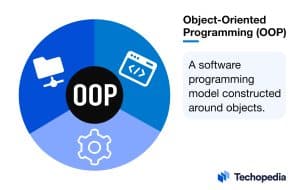What is Object-Oriented Programming (OOP)?
Object-oriented programming (OOP) is a style of programming that uses modular components to build large, complex software applications.
The design principles of object-oriented programming allow developers to build a basic version of a self-contained unit of code and then extend its functionality incrementally and iteratively.
In theory, OOP should be easy to learn. At a fundamental level, this programming style is based on how people organize information and interact with the world around them.
The problem is that OOP uses terms that can be confusing for beginners. Taking time and understanding the vocabulary is important because OOP concepts have become integral to most aspects of Scrum, Lean, and Agile software engineering.

Key Takeaways
- Object-oriented programming can have a high learning curve.
- OOP builds software around classes that represent real-world entities or concepts.
- Classes act as templates that allow developers to create modular units of code called objects.
- Each object contains data and specifies the operations that can manipulate the data.
- Software applications that are designed with OOP principles typically conduct operations on objects to ensure data integrity and consistency.
How OOP Works
OOP developers build software by using templates called classes. Classes are designed to structure code in self-contained modular units called objects. Each class defines what kind of data an object can hold and what actions the object can perform.
The principles of encapsulation and abstraction allow object instances to be repurposed and reused. Encapsulation bundles data and actions together to create an object. Abstraction hides the object’s inner workings and provides an interface that allows objects to interact by sending messages.
The principles of inheritance and polymorphism allow classes to be modified so they can be used for different purposes. Essentially, inheritance allows developers to create new classes that are based on existing classes, and polymorphism allows objects of different classes to be treated as if they belong to the same class.
OOP Concepts
OOP concepts are intended to be understood intuitively because they are modeled after real-world interactions, but the terminology can be confusing. The key is to find simple explanations for each concept. Hopefully, this OOP definition will help.
Here are some very simple explanations of terms you are likely to run into when reading about OOP or listening to a discussion that involves object-oriented programming:
- Class is a template that defines the structure and behaviors of modular, self-contained units of code.
- Objects are modular, self-contained units of code.
- Instance is a specific object.
- Attribute is data stored inside an object.
- Method describes how an object can interact with other data or objects.
- Constructor is a mechanism that ensures an object is in a valid state before it’s used.
- Method call is an instruction that tells an object what task to perform.
- Derived class is a new class based on an existing class.
- Base class is the original class that provides common structure and behaviors to subclasses.
- Subclass is a synonym for derived class.
- Message passing is how objects communicate with each other.
Four Main Principles of OOP
The four main principles of OOP that support modular, reusable, and maintainable code are encapsulation, abstraction, inheritance, and polymorphism.
Here is a more technical explanation for each principle:
Popular OOP Languages
Popular languages that support OOP include Java, Python, C++, C#, Ruby, JavaScript, TypeScript, PHP, and Swift.
Each language offers unique features that make it more suitable for certain types of applications or environments. The choice of programming language depends on the specific project requirements, platform compatibility, developer expertise, and the available ecosystem of software libraries and tools.
Object-Oriented Programming Examples
Salesforce CRM software is a well-known example of how OOP can be effectively used to build robust, customizable, and scalable enterprise applications. Salesforce CRM data is organized into objects whose attributes and interactions with other objects mirror real-world relationships.
SAP has used OOP principles to support legacy software. SAP’s primary programming language is ABAP (Advanced Business Application Programming). Arguably, ABAP was not specifically designed for OOP, but ABAP Objects made it very clear that SAP developers value OOP concepts.
OOP Pros and Cons
Object-oriented programming offers powerful modeling tools and methodologies, but it also comes with its own set of challenges, especially as projects grow in complexity.
- Improved code organization and readability
- Easier maintenance and debugging
- Increased code reuse and reduced redundancy
- More accurate modeling of complex systems
- Support for collaborative development
- High learning curve
- Requires careful planning
- Risk of creating unnecessary classes and objects
- Misuse of inheritance can complicate development
- Debugging is challenging when behaviors are distributed across classes
The Bottom Line
If you are considering using OOP, it can be useful to consider object-oriented programming’s meaning and implications in the context of a specific project and programming language. An OOP approach is useful for managing large enterprise-level projects that will be improved iteratively over a number of years, but it can be overkill for small development projects with tight deadlines.
FAQs
What is Object-Oriented Programming in simple terms?
What is an example of object-oriented programming?
What are the four basics of OOP?
Is C++ an object-oriented programming?
Is Python an OOP?
References
- Object-Oriented Messaging (Atomicobject)
- Encapsulation (computer programming) – Wikipedia (En.wikipedia)
- Abstraction (computer science) – Wikipedia (En.wikipedia)
- What is Inheritance in Object-Oriented Programming? – Codecademy Blog (Codecademy)
- C# OOP Primer: Generics | romig.dev (Romig)
- Polymorphism in Java – GeeksforGeeks (Geeksforgeeks)
- Difference between a parent class and super class (Stackoverflow)
- Java Introduction (W3schools)
- Interactive tutorials – A tour of C# | Microsoft Learn (Learn.microsoft)
- An Introduction to Object-Oriented JavaScript – Back-End Engineering Curriculum – Turing School of Software and Design (Backend.turing)
- Principles of Object-oriented Programming in TypeScript | AppSignal Blog (Blog.appsignal)
- Object-Oriented Programming Design Basics for PHP Apps | Zend by Perforce (Zend)
- Object Oriented Programming in Swift | Kodeco (Kodeco)
- ABAP Objects as a Programming Model – ABAP Keyword Documentation (Help.sap)






